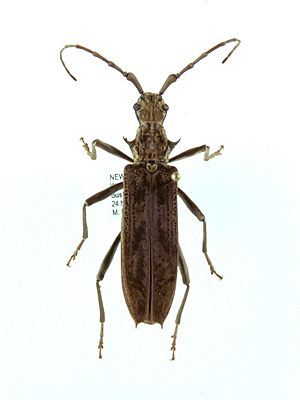Spiny longhorn facts for kids
Quick facts for kids Blosyropus spinosus |
|
|---|---|
 |
|
| Dorsal view of a Blosyropus spinosus specimen in the Whanganui Regional Museum | |
| Scientific classification | |
| Kingdom: | |
| Phylum: | |
| Class: | |
| Order: | |
| Suborder: | |
| Superfamily: |
Chrysomeloidea
|
| Family: | |
| Subfamily: |
Cerambycinae
|
| Tribe: |
Phlyctaenodini
|
| Genus: |
Blosyropus
|
| Species: |
B. spinosus
|
| Binomial name | |
| Blosyropus spinosus Redtenbacher, 1868
|
|
The Blosyropus spinosus, often called the spiny longhorn or spiny silver-pine borer, is a special kind of longhorn beetle. It is very rare and only found in New Zealand. This means it is endemic to New Zealand. Its names in the Māori language are howaka and kapapa.
Contents
What is Blosyropus spinosus?
The Blosyropus spinosus is one of the biggest beetles that lives only in New Zealand. It can grow to be about 46 millimeters long. That's almost two inches!
This beetle is active at night, which means it is nocturnal. It also cannot fly. Both male and female Blosyropus spinosus beetles have very short or missing hind wings.
Appearance of the Spiny Longhorn
The Blosyropus spinosus beetle is dark brown. It has yellowish hairs all over its body.
What makes this beetle easy to spot are its unique spines. It has two spines on its head, one above each eye. It also has four spines on its body part called the pronotum. This is the section just before its wing covers, known as the elytra.
Where Does the Spiny Longhorn Live?
Blosyropus spinosus has been found in forests across many parts of New Zealand. It likes to live in places where there are lots of trees.
Beetle Homes and Food
The young beetles, called larvae, live inside rotting logs. They have been found in many different types of trees. These include tawa, Dracophyllum, pōhutukawa, manoao (silver pine), and red beech. They also live in podocarp forests.
Because it is so rare, the Blosyropus spinosus is listed as a Threatened Species. This means it needs protection to survive.
Life Cycle and Behavior
Adult Blosyropus spinosus beetles are often drawn to lights at night. This is how scientists sometimes find them.
How the Larvae Grow
When the female beetle lays her eggs, she places them near the top of a tree. Once the eggs hatch, the larvae begin to tunnel downwards. They eat the rotting wood as they go.
When a larva is ready to change into an adult beetle, it creates a large chamber. This special room is usually at the bottom of the tree. This chamber opens to the outside, but the larva plugs it with chewed wood. This wood has not been digested.
After the beetle finishes changing inside this chamber, it might stay there for a while. It can spend the winter or "hibernate" inside its pupal chamber before coming out.
Images for kids
-
Head of Blosyropus spinosus in the Auckland Museum collection showing the four thorax spines.



